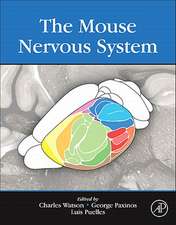Cellular and Molecular Bases of Biological Clocks: Models and Mechanisms for Circadian Timekeeping
Autor Leland N. Jr. Edmundsen Limba Engleză Paperback – 21 oct 2011
Preț: 651.34 lei
Preț vechi: 766.28 lei
-15% Nou
Puncte Express: 977
Preț estimativ în valută:
124.64€ • 130.39$ • 103.53£
124.64€ • 130.39$ • 103.53£
Carte tipărită la comandă
Livrare economică 02-16 aprilie
Preluare comenzi: 021 569.72.76
Specificații
ISBN-13: 9781461283294
ISBN-10: 1461283299
Pagini: 520
Ilustrații: XVII, 497 p.
Dimensiuni: 155 x 235 x 27 mm
Greutate: 0.72 kg
Ediția:Softcover reprint of the original 1st ed. 1988
Editura: Springer
Colecția Springer
Locul publicării:New York, NY, United States
ISBN-10: 1461283299
Pagini: 520
Ilustrații: XVII, 497 p.
Dimensiuni: 155 x 235 x 27 mm
Greutate: 0.72 kg
Ediția:Softcover reprint of the original 1st ed. 1988
Editura: Springer
Colecția Springer
Locul publicării:New York, NY, United States
Public țintă
ResearchCuprins
1. Introduction.- 1.1 Temporal Organization.- 1.2 General Properties of Circadian Rhythms.- 1.3 Analogies with Shorter Periodicities.- 2. Circadian Organization in Eukaryotic Microorganisms.- 2.1 Circadian Rhythms in Protozoa.- 2.2 Circadian Rhythms in Unicellular Algae.- 2.3 Circadian Rhythms in Fungi.- 3. Cell Cycle Clocks.- 1.1 Regulation of the Cell Division Cycle.- 3.2 Cell Division Cycles and Circadian Oscillators.- 4. Experimental Approaches to Circadian Clock Mechanisms.- 4.1 Quest for an Anatomical Locus: Autonomous Oscillators in Isolated Organs, Tissues, and Cells.- 4.2 Tracing the Entrainment Pathway for Light Signals.- 4.3 Dissection of the Clock: Perturbation by Chemicals.- 4.1 Dissection of the Clock: Molecular Genetics.- 4.5 Characterizing the Coupling Pathway: Transducing Mechanisms Between Clocks and Their Hands.- 5. Biochemical and Molecular Models for Circadian Clocks.- 5.1 In Vitro Molecular Models.- 5.2 Biochemical Feedback Loop and Network Models.- 5.1 Transcriptional (Tape-Reading) Models.- 5.2 Membrane Models.- 5.3 Problems and Prospects.- 6. General Considerations and Conclusions.- 6.1 Evolution of Circadian Rhythmicity.- 6.2 Multiple Cellular Oscillators.- 6.3 The Breakdown of Temporal Organization at the Cellular Level.- 6.4 Cellular Aspects of Chronopharmacology and Chronotherapy.- 6.5 Cellular Clocks in Development and Aging.- 6.6 Epilogue.- References.- Author Index.













